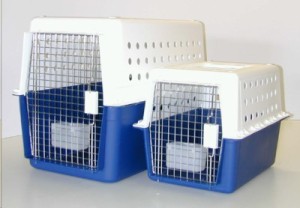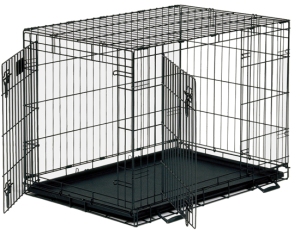A dog crate can come in handy for many various reasons and scenarios. A dog who has been correctly crate trained will see their crate as a place where they can feel safe, secure, comfortable and relaxed.
What are dog crates used for?
-Toilet training.
-Keeping your dog safe and secure while in a car.
-Taking your dog on holiday.
-Vet visits.
-Confinement due to surgery or injury.
-A safe and secure place for your dog to relax.
Are dog crates cruel?
If used for the correct reasons they are not cruel in the slightest. A crate can provide a safe, secure place for your dog to feel at ease. A crate should never be used as punishment or as a time-out area, this will cause your dog to associate the crate with negative experiences and fear it.
Dogs should not be left in a crate for long periods of time. If you are at work or out all day you should not use a crate to keep your dog confined, consider a dog minder or dog day care instead.
Do not leave your dog in a crate if:
-They suffer from separation anxiety.
-If they show any signs of anxiety when in a crate.
-If they don’t have sufficient bladder or bowel control.
-If they are suffering from diarrhoea or vomiting.
-If it is too hot.
What type of dog crate should I get?
-Plastic crates. These crates are airline approved and extremely durable, however they cannot be folded down so they require adequate storage space.

Image credit: k9homes.com.au
-Wire crates. These crates are collapsible, well ventilated, and allow the dog a clear view of its surroundings. However they aren’t as durable as the plastic crates.

Image credit: bowhouse.com.au
-Fabric crates. These crates are collapsible and light weight, however they can be easily tipped over or chewed through.

Image credit: k9softdogcrates.com.au
What size should the dog crate be?
The crate should be big enough for your dog to stand up, turn around and lie down, without being overly large.
How do I get my dog used to being in a crate?
-Place the crate in a familiar place of the house with the door open so your dog can go in and out as it pleases. Never force your dog into the crate.
-Don’t close the door of the crate until your dog is comfortable and relaxed sitting or lying in it.
-Place your dogs bed or blanket in the crate so your dog sees it as just another place they can rest.
-Only associate the crate with positive and pleasant things. Place a bone or toy in the crate for your dog to enjoy.
-Feed your dog their meals while in the crate.
-Every time your dog freely goes into the crate reward their behaviour.


Never, ever, send your dog to its crate as punishment! I am rather hoping that the reason is obvious!
LikeLike
Agree with you 100%! A crate should be a place where your dog can go to rest and feel safe. It should never be used for negative experiences.
LikeLike
When Ray came home with us for the first time, his crate (we call it his den) was the first place he checked out and he settled down there. I agree, they love small places.
LikeLike
My lab, Chica, loved her crate. We kept the door open when we were home and she often went in on her own. We didn’t need to use it often, but liked to have her trained so it was easier to travel with her. My wheaten, Farley, is create trained too, but we spent 5 years sailing with him and didn’t have room for one. He found his own small spots on the boat he could hide in. I think he was making his own crate. I think both dogs felt safe in there crate. I like the advice you’ve given about training. All about kindness!
LikeLike
I think a lot of people don’t realise that dogs actually enjoy finding a small space to hide in when they want to rest. After purchasing mine I left it open around the house so the dogs could get used to it and within a day or two I would find them sleeping in it. 😀
LikeLiked by 1 person